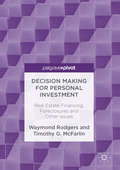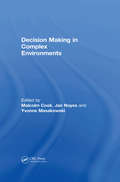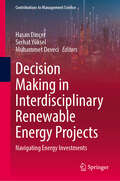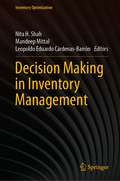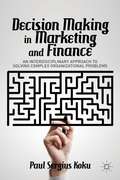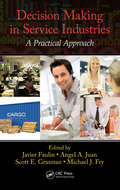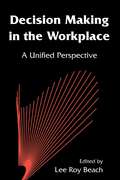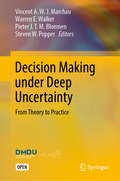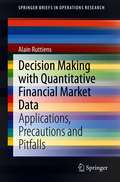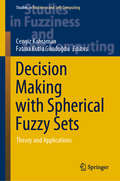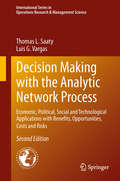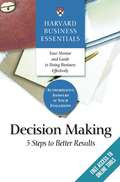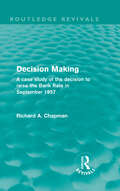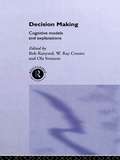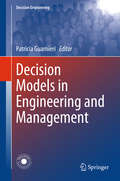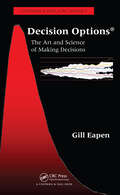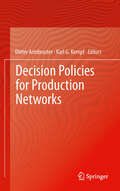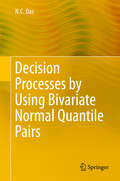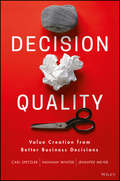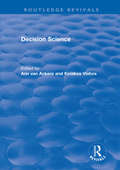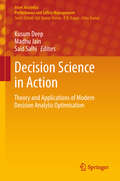- Table View
- List View
Decision Making for Personal Investment
by Waymond Rodgers Timothy G. McfarlinThis book presents a personal financial decision making model based on six dominant decision making pathways. It outlines each pathway in detail before focusing on real estate investments in the second part of the book. Based on the authors extensive research into investment decision making, decision modeling and experimental psychology, strategies presented in this book will facilitate more successful investment decision making.
Decision Making in Complex Environments
by Malcolm Cook Jan Noyes Yvonne MasakowskiMany complex systems in civil and military operations are highly automated with the intention of supporting human performance in difficult cognitive tasks. The complex systems can involve teams or individuals working on real-time supervisory control, command or information management tasks where a number of constraints must be satisfied. Decision Making in Complex Environments addresses the role of the human, the technology and the processes in complex socio-technical and technological systems. The aim of the book is to apply a multi-disciplinary perspective to the examination of the human factors in complex decision making. It contains more than 30 contributions on key subjects such as military human factors, team decision making issues, situation awareness, and technology support. In addition to the major application area of military human factors there are chapters on business, medical, governmental and aeronautical decision making. The book provides a unique blend of expertise from psychology, human factors, industry, commercial environments, the military, computer science, organizational psychology and training that should be valuable to academics and practitioners alike.
Decision Making in Interdisciplinary Renewable Energy Projects: Navigating Energy Investments (Contributions to Management Science)
by Hasan Dinçer Serhat Yüksel Muhammet DeveciThis edited book presents a comprehensive analysis of the multidimensional aspects associated with decision making in renewable energy investment projects. It delves into the interplay between interdisciplinary studies, sustainability considerations, and circular economy principles within the renewable energy sector. By examining the impact of these interconnected domains, the book offers valuable insights into the challenges and opportunities inherent in decision making for renewable energy investments. The book is tailored to a diverse audience, including researchers, scholars, and professionals in the fields of renewable energy, sustainability, circular economy, and business management. It is equally suitable for graduate and undergraduate students studying environmental studies, renewable energy, sustainability, and related disciplines. Professionals working in the renewable energy industry, including project developers, investors, and policymakers, will find valuable insights to inform their decision-making processes. Additionally, engineers, economists, social scientists, and environmental consultants interested in interdisciplinary studies and their intersection with renewable energy will benefit from the book's comprehensive analysis.
Decision Making in Inventory Management (Inventory Optimization)
by Nita H. Shah Mandeep Mittal Leopoldo Eduardo Cárdenas-BarrónThis book provides several inventory models for making the right decision in inventory management under different environments. Basically, the optimal ordering policies are determined for situations with and without shortages in production-inventory systems. The chapters in the book include various features of inventory modeling i.e., inflation, deterioration, supply chain, learning, credit financing, carbon emission policy, stock-dependent demand, among others. The book is a useful resource for academicians, researchers, students, practitioners, and managers who can be benefited with the policies provided in the chapters of the book.
Decision Making in Manufacturing Environment Using Graph Theory and Fuzzy Multiple Attribute Decision Making Methods
by R. Venkata RaoDecision Making in Manufacturing Environment Using Graph Theory and Fuzzy Multiple Attribute Decision Making Methods presents the concepts and details of applications of MADM methods. A range of methods are covered including Analytic Hierarchy Process (AHP), Technique for Order Preference by Similarity to Ideal Solution (TOPSIS), VIšekriterijumsko KOmpromisno Rangiranje (VIKOR), Data Envelopment Analysis (DEA), Preference Ranking METHod for Enrichment Evaluations (PROMETHEE), ELimination Et Choix Traduisant la Realité (ELECTRE), COmplex PRoportional ASsessment (COPRAS), Grey Relational Analysis (GRA), UTility Additive (UTA), and Ordered Weighted Averaging (OWA). The existing MADM methods are improved upon and three novel multiple attribute decision making methods for solving the decision making problems of the manufacturing environment are proposed. The concept of integrated weights is introduced in the proposed subjective and objective integrated weights (SOIW) method and the weighted Euclidean distance based approach (WEDBA) to consider both the decision maker's subjective preferences as well as the distribution of the attributes data of the decision matrix. These methods, which use fuzzy logic to convert the qualitative attributes into the quantitative attributes, are supported by various real-world application examples. Also, computer codes for AHP, TOPSIS, DEA, PROMETHEE, ELECTRE, COPRAS, and SOIW methods are included. This comprehensive coverage makes Decision Making in Manufacturing Environment Using Graph Theory and Fuzzy Multiple Attribute Decision Making Methods a key reference for the designers, manufacturing engineers, practitioners, managers, institutes involved in both design and manufacturing related projects. It is also an ideal study resource for applied research workers, academicians, and students in mechanical and industrial engineering.
Decision Making in Marketing and Finance
by Paul Sergius KokuAs interest in MBA programs and business schools more generally continues to grow, it is essential that teachers and students analyse their established strategy for decision making. The successful use of case studies in business schools shows the superior outcomes of an interdisciplinary approach to problem solving. Disappointingly, functional departmental silos within universities still exist and keep problem solvers from seeing all the effects of a given issue. In addition to providing teaching material, Decision Making in Marketing and Finance provides motives and strategies to break down functional silos in making informed and effective business and finance decisions. Koku achieves his goal by showing how value can be created for shareholders and other stakeholders, linking marketing and finance decision making, and providing much-needed teaching materials for an interdisciplinary approach to case analysis.
Decision Making in Service Industries: A Practical Approach
by Javier Faulin Angel A. Juan Michael J. Fry Scott E. GrasmanIn real-life scenarios, service management involves complex decision-making processes usually affected by random or stochastic variables. Under such uncertain conditions, the development and use of robust and flexible strategies, algorithms, and methods can provide the quantitative information necessary to make better business decisions. Decision M
Decision Making in the Workplace: A Unified Perspective
by Lee Roy BeachMany, if not most, of one's important decisions are made in the context of one's work. However, because workplace decisions cover such a broad range of issues, it often is difficult to detect underlying commonalities in how they are made, and in how things go wrong when they do go wrong. As a result, there are nearly as many different descriptions of workplace decisions as there are decisions themselves. In this volume, the best features of these diverse descriptions are unified in a new, intuitively compelling view of decision making called "Image Theory." The result is a clear picture of real-life, day-to-day workplace decision making that allows us to think constructively about how such decisions are made and about how to improve them when improvement is necessary.
Decision Making under Deep Uncertainty: From Theory To Practice
by Steven W. Popper Warren E. Walker Vincent A. W. J. Marchau Pieter J. T. M. BloemenThis open access book focuses on both the theory and practice associated with the tools and approaches for decisionmaking in the face of deep uncertainty. It explores approaches and tools supporting the design of strategic plans under deep uncertainty, and their testing in the real world, including barriers and enablers for their use in practice. The book broadens traditional approaches and tools to include the analysis of actors and networks related to the problem at hand. It also shows how lessons learned in the application process can be used to improve the approaches and tools used in the design process. The book offers guidance in identifying and applying appropriate approaches and tools to design plans, as well as advice on implementing these plans in the real world. For decisionmakers and practitioners, the book includes realistic examples and practical guidelines that should help them understand what decisionmaking under deep uncertainty is and how it may be of assistance to them. <p><p> Decision Making under Deep Uncertainty: From Theory to Practice is divided into four parts. Part I presents five approaches for designing strategic plans under deep uncertainty: Robust Decision Making, Dynamic Adaptive Planning, Dynamic Adaptive Policy Pathways, Info-Gap Decision Theory, and Engineering Options Analysis. Each approach is worked out in terms of its theoretical foundations, methodological steps to follow when using the approach, latest methodological insights, and challenges for improvement. In Part II, applications of each of these approaches are presented. Based on recent case studies, the practical implications of applying each approach are discussed in depth. Part III focuses on using the approaches and tools in real-world contexts, based on insights from real-world cases. Part IV contains conclusions and a synthesis of the lessons that can be drawn for designing, applying, and implementing strategic plans under deep uncertainty, as well as recommendations for future work.
Decision Making with Quantitative Financial Market Data: Applications, Precautions and Pitfalls (SpringerBriefs in Operations Research)
by Alain RuttiensUse of quantitative data, especially in financial markets, may provide rapid results due to the ease-of-use and availability of fast computational software, but this book advises caution and helps to understand and avoid potential pitfalls.It deals with often underestimated issues related to the use of financial quantitative data, such as non-stationarity issues, accuracy issues and modeling issues. It provides practical remedies or ways to develop new calculation methodologies to avoid pitfalls in using data, as well as solutions for risk management issues in financial market. The book is intended to help professionals in financial industry to use quantitative data in a safer way.
Decision Making with Spherical Fuzzy Sets: Theory and Applications (Studies in Fuzziness and Soft Computing #392)
by Cengiz Kahraman Fatma Kutlu GündoğduThis book introduces readers to the novel concept of spherical fuzzy sets, showing how these sets can be applied in practice to solve various decision-making problems. It also demonstrates that these sets provide a larger preference volume in 3D space for decision-makers. Written by authoritative researchers, the various chapters cover a large amount of theoretical and practical information, allowing readers to gain an extensive understanding of both the fundamentals and applications of spherical fuzzy sets in intelligent decision-making and mathematical programming.
Decision Making with the Analytic Network Process
by Thomas L. Saaty Luis G. VargasThe Analytic Network Process (ANP), developed by Thomas Saaty in his work on multicriteria decision making, applies network structures with dependence and feedback to complex decision making. This new edition of Decision Making with the Analytic Network Process is a selection of the latest applications of ANP to economic, social and political decisions, and also to technological design. The ANP is a methodological tool that is helpful to organize knowledge and thinking, elicit judgments registered in both in memory and in feelings, quantify the judgments and derive priorities from them, and finally synthesize these diverse priorities into a single mathematically and logically justifiable overall outcome. In the process of deriving this outcome, the ANP also allows for the representation and synthesis of diverse opinions in the midst of discussion and debate. The book focuses on the application of the ANP in three different areas: economics, the social sciences and the linking of measurement with human values. Economists can use the ANP for an alternate approach for dealing with economic problems than the usual mathematical models on which economics bases its quantitative thinking. For psychologists, sociologists and political scientists, the ANP offers the methodology they have sought for some time to quantify and derive measurements for intangibles. Finally the book applies the ANP to provide people in the physical and engineering sciences with a quantitative method to link hard measurement to human values. In such a process, one is able to interpret the true meaning of measurements made on a uniform scale using a unit.
Decision Making: 5 Steps To Better Results (Harvard Business Essentials)
by Harvard Business School Press StaffDecision making is a critical part of management, and bad choices can damage careers and the bottom line. This book offers the tools and advice managers need to avoid common biases and arrive at and implement decisions that are both sound and ethical. The Harvard Business Essentials series provides comprehensive advice, personal coaching, background information, and guidance on the most relevant topics in business. Whether you are a new manager seeking to expand your skills or a seasoned professional looking to broaden your knowledge base, these solution-oriented books put reliable answers at your fingertips.
Decision Making: A case study of the decision to raise the Bank Rate in September 1957 (Routledge Revivals)
by Richard A. ChapmanOriginally published in 1968, Richard Chapman’s pioneering work illuminates the process of decision making by analysis of a particular example: the decision to raise the Bank Rate in September, 1957. The legal responsibility for a decision may be easy to pinpoint; in this case the Court of Directors of the Bank of England bear this but six weeks of negotiation separate their formal statement from the Chancellor of the Exchequer’s advice to the Treasury to consider effecting ‘a measure of deflation in the economy’. These six weeks of consultation between the Bank and the Treasury proceeding in ‘the pattern of a formal dance’ are analysed and a necessary by-product of this case-study is a closer understanding of how the Treasury and the Bank of England work together. These details are derived mainly from the evidence, and deductions from it, presented to the Bank Rate Tribunal and the Radcliffe Committee on the Working of the Monetary System. Professor Chapman gives his particular findings about decision making a wider application still by forming reasoned hypotheses and informed generalisations about public administration in Britain.
Decision Making: Cognitive Models and Explanations (Frontiers of Cognitive Science #Vol. 1)
by W. Ray Crozier Rob Ranyard Ola SvensonThis book offers an exciting new collection of recent research on the actual processes that humans use when making decisions in their everyday lives and in business situations. The contributors use cognitive psychological techniques to break down the constituent processes and set them in their social context. The contributors are from many different countries and draw upon a wide range of techniques, making this book a valuable resource to cognitive psychologists in applied settings, economists and managers.
Decision Models in Engineering and Management
by Patricia GuarnieriProviding a comprehensive overview of various methods and applications in decision engineering, this book presents chapters written by a range experts in the field. It presents conceptual aspects of decision support applications in various areas including finance, vendor selection, construction, process management, water management and energy, agribusiness , production scheduling and control, and waste management. In addition to this, a special focus is given to methods of multi-criteria decision analysis. Decision making in organizations is a recurrent theme and is essential for business continuity. Managers from various fields including public, private, industrial, trading or service sectors are required to make decisions. Consequently managers need the support of these structured methods in order to engage in effective decision making. This book provides a valuable resource for graduate students, professors and researchers of decision analysis, multi-criteria decision analysis and group decision analysis. It is also intended for production engineers, civil engineers and engineering consultants.
Decision Options: The Art and Science of Making Decisions (Chapman & Hall/CRC Finance Series)
by Gill EapenThrough theory and case studies, this book details how uncertainty and flexibility can be evaluated to assist in making better investment decisions in companies. It delivers an excellent balance of theory and practice in the area of investment decision making, demonstrates how financial and real options are related, and describes the theoretical underpinnings of both. The author presents case studies from diverse industries, including life sciences, pharmaceuticals, commodities, energy, technology, manufacturing, and financial services. He also looks at how organizations can become successful using a holistic framework that integrates uncertainty and flexibility.
Decision Policies for Production Networks
by Dieter Armbruster Karl G. KempfThe financial results of any manufacturing company can be dramatically impacted by the repetitive decisions required to control a complex production network be it a network of machines in a factory; a network of factories in a company; or a network of companies in a supply chain. Decision Policies for Production Networks presents recent convergent research on developing policies for operating production networks including details of practical control and decision techniques which can be applied to improve the effectiveness and economic efficiency of production networks worldwide. Researchers and practitioners come together to explore a wide variety of approaches to a range of topics including: WIP and equipment management policies, Material release policies, Machine, factory, and supply chain network policies for delivery in the face of supply and demand variability, and Conflicts between complex production network models and their controlling policies. Case studies and relevant mathematical techniques are included to support and explain techniques such as heuristics, global and hierarchical optimization, control theory and filtering approaches related to complex systems or traffic flows. Decision Policies for Production Networks acts as handbook for researchers and practitioners alike, providing findings and information which can be applied to develop methods and advance further research across production networks.
Decision Process: Five Key Steps
by Richard LueckeThis chapter illustrates how you can organize the decision-making process into five simple steps. Using these techniques reveals the pros, cons, risks, and trade-offs of any given decision.
Decision Processes by Using Bivariate Normal Quantile Pairs
by N. C. DasThis book discusses equi-quantile values and their use in generating decision alternatives under the twofold complexities of uncertainty and dependence, offering scope for surrogating between two alternative portfolios when they are correlated. The book begins with a discussion on components of rationality and learning models as indispensable concepts in decision-making processes. It identifies three-fold complexities in such processes: uncertainty, dependence and dynamism. The book is a novel attempt to seek tangible solutions for such decision problems. To do so, four hundred tables of bi-quantile pairs are presented for carefully chosen grids. In fact, it is a two-variable generalization of the inverse normal integral table, which is used in obtaining bivariate normal quantile pairs for the given values of probability and correlation. When making decisions, only two of them have to be taken at a time. These tables are essential tools for decision-making under risk and dependence, and offer scope for delving up to a single step of dynamism. The book subsequently addresses averments dealing with applications and advantages. The content is useful to empirical scientists and risk-oriented decision makers who are often required to make choices on the basis of pairs of variables. The book also helps simulators seeking valid confidence intervals for their estimates, and particle physicists looking for condensed confidence intervals for Higgs-Boson utilizing the Bose-Einstein correlation given the magnitude of such correlations. Entrepreneurs and investors as well as students of management, statistics, economics and econometrics, psychology, psychometrics and psychographics, social sciences, geographic information system, geology, agricultural and veterinary sciences, medical sciences and diagnostics, and remote sensing will also find the book very useful.
Decision Quality: Value Creation from Better Business Decisions
by Hannah Winter Jennifer Meyer Carl SpetzlerFew things are as valuable in business, and in life, as the ability to make good decisions. Can you imagine how much more rewarding your life and your business would be if every decision you made were the best it could be? Decision Quality empowers you to make the best possible choice and get more of what you truly want from every decision. Dr. Carl Spetzler is a leader in the field of decision science and has worked with organizations across industries to improve their decision-making capabilities. He and his co-authors, all experienced consultants and educators in this field, show you how to frame a problem or opportunity, create a set of attractive alternatives, identify relevant uncertain information, clarify the values that are important in the decision, apply tools of analysis, and develop buy-in among stakeholders. Their straightforward approach is elegantly simple, yet practical and powerful. It can be applied to all types of decisions. Our business and our personal lives are marked by a stream of decisions. Some are small. Some are large. Some are life-altering or strategic. How well we make those decisions truly matters. This book gives you a framework and thinking tools that will help you to improve the odds of getting more of what you value from every choice. Many people are satisfied with 'good enough' when making important decisions. This book provides a method that will take you and your co-workers beyond 'good enough' to true Decision Quality.
Decision Science (Routledge Revivals)
by Ann Van Ackere Kiriakos VlahosThis title was first published in 2000. This text is part of the "International Library of Management", which aims to present a comprehensive core reference series comprised of significant and influencial articles by the authorities in the management studies field. The collection of essays is both international and interdisciplinary in scope and aims to provide an entry point for investigating the myriad of study within the discipline.
Decision Science for Housing and Community Development
by Michael P. Johnson Armagan Bayram Senay Solak Rachel Bogardus Drew Jeffrey M. Keisler David A. TurcotteA multidisciplinary approach to problem-solving in community-based organizations using decision models and operations research applications A comprehensive treatment of public-sector operations research and management science, Decision Science for Housing and Community Development: Localized and Evidence-Based Responses to Distressed Housing and Blighted Communities addresses critical problems in urban housing and community development through a diverse set of decision models and applications. The book represents a bridge between theory and practice and is a source of collaboration between decision and data scientists and planners, advocates, and community practitioners. The book is motivated by the needs of community-based organizations to respond to neighborhood economic and social distress, represented by foreclosed, abandoned, and blighted housing, through community organizing, service provision, and local development. The book emphasizes analytic approaches that increase the ability of local practitioners to act quickly, thoughtfully, and effectively. By doing so, practitioners can design and implement responses that reflect stakeholder values associated with healthy and sustainable communities; that benefit from increased organizational capacity for evidence-based responses; and that result in solutions that represent improvements over the status quo according to multiple social outcome measures. Featuring quantitative and qualitative analytic methods as well as prescriptive and exploratory decision modeling, the book also includes: Discussions of the principles of decision theory and descriptive analysis to describe ways to identify and quantify values and objectives for community development Mathematical programming applications for real-world problem solving in foreclosed housing acquisition and redevelopment Applications of case studies and community-engaged research principles to analytics and decision modeling Decision Science for Housing and Community Development: Localized and Evidence-Based Responses to Distressed Housing and Blighted Communities is an ideal textbook for upper-undergraduate and graduate-level courses in decision models and applications; humanitarian logistics; nonprofit operations management; urban operations research; public economics; performance management; urban studies; public policy; urban and regional planning; and systems design and optimization. The book is also an excellent reference for academics, researchers, and practitioners in operations research, management science, operations management, systems engineering, policy analysis, city planning, and data analytics.
Decision Science in Action: Theory And Applications Of Modern Decision Analytic Optimisation (Asset Analytics)
by Kusum Deep Madhu Jain Said SalhiThis book provides essential insights into a range of newly developed numerical optimization techniques with a view to solving real-world problems. Many of these problems can be modeled as nonlinear optimization problems, but due to their complex nature, it is not always possible to solve them using conventional optimization theory. Accordingly, the book discusses the design and applications of non-conventional numerical optimization techniques, including the design of benchmark functions and the implementation of these techniques to solve real-world optimization problems. The book’s twenty chapters examine various interesting research topics in this area, including: Pi fraction-based optimization of the Pantoja–Bretones–Martin (PBM) antenna benchmarks; benchmark function generators for single-objective robust optimization algorithms; convergence of gravitational search algorithms on linear and quadratic functions; and an algorithm for the multi-variant evolutionary synthesis of nonlinear models with real-valued chromosomes. Delivering on its promise to explore real-world scenarios, the book also addresses the seismic analysis of a multi-story building with optimized damper properties; the application of constrained spider monkey optimization to solve portfolio optimization problems; the effect of upper body motion on a bipedal robot’s stability; an ant colony algorithm for routing alternate-fuel vehicles in multi-depot vehicle routing problems; enhanced fractal dimension-based feature extraction for thermal face recognition; and an artificial bee colony-based hyper-heuristic for the single machine order acceptance and scheduling problem. The book will benefit not only researchers, but also organizations active in such varied fields as Aerospace, Automotive, Biotechnology, Consumer Packaged Goods, Electronics, Finance, Business & Banking, Oil, Gas & Geosciences, and Pharma, to name a few.
Decision Sciences for COVID-19: Learning Through Case Studies (International Series in Operations Research & Management Science #320)
by Said Ali Hassan Ali Wagdy Mohamed Khalid Abdulaziz AlnowibetThis book presents best practices involving applications of decision sciences, business tactics and behavioral sciences for COVID-19. Addressing concrete problems in these vital fields, it focuses on theoretical and methodological investigations of managerial decisions that drive production and service enterprises’ productivity and success. Moreover, it presents optimization techniques and tools that can also be adopted for other applications in various research areas after a thorough analysis of the specific problem. The book is intended for researchers and practitioners seeking optimum solutions to real-life problems in various application areas concerning COVID-19, helping them make scientifically founded decisions.
